Abstract
Despite the COVID-19 pandemic, the current era offers the ultimate possibility for prosperous corporate life, especially in the transport sector. Industry 4.0 covers artificial intelligence, big data, or industrial IoT, and thus spatial cognition algorithms, traffic flow prediction, autonomous vehicles, and smart sustainable mobility are not far away. The mentioned tools have already been implemented by enterprises in emerging countries. This exploration focused on transportation within the V4 region from 2016–2021. This article aims to confirm the positive sequel of applying Industry 4.0 to chosen indicators of profitability. The positive, negative, or no shift in the development of 534 businesses was based on Pettitt’s test. The Pearson chi-square test disclosed the significant dependency between Industry 4.0 and shifts in profitability ratios. Then, more than 25% of enterprises involved in Industry 4.0 had positive shifts in ROA, ROC, ROS, and ROR. The research proved not only its balanced effect but also its augmented force through the z-test of proportion. This investigation may provide multiple proofs for connected sectors with transportation to adapt the tools of Industry 4.0 and deliver the call for the governments in the V4 region to make this tool more achievable.
MSC:
62M10; 62P20; 91B02
1. Introduction
The modern development of the country’s economy is impossible without creating a highly efficient transport sector [1]. The transport sector faces various challenges, including the consequences of the COVID-19 pandemic, increasing regulatory requirements, increasing fuel prices, and especially the need to adopt new technologies and business models [2,3,4]. Industry 4.0 (I4.0) and its tools represent the top of new technologies and are found on the Internet of Things sensing networks, cyber-physical system-based manufacturing, cognitive automation, and deep learning-assisted smart [5]. I4.0 is still generating attention despite entering a new decade and being used in increasing economic sectors [6]. It integrates smart and connected production systems and leads to increased productivity, sustainability, and energy efficiency while optimizing competitiveness [7]. The transport sector may profit from applying Industry 4.0 not only in the mentioned areas but also in profitability [8]. It is crucial to introduce these modern technologies in this area of the economy [9,10].
Table 1 provides a summary of the last incentives for the issue. Seven areas of Industry 4.0 (digital twins, AI, IoT, autonomous vehicles, smart cities, machine learning, and big data) are related to transportation. It demonstrates the significant implementation of Industry 4.0 for transportation and its current mapping through studies from development and emerging markets.

Table 1.
Summary of focused incentives from the literature review. Source: own research.
The mentioned studies drawn in Table 1 are oriented towards a systematic literature review and bibliometric analysis but not to an empirical and quantitative expression of the consequences of Industry 4.0 for transport enterprises. There is a research gap to prove the positive effect of applying the phenomenon of Industry 4.0 across countries based on robust sample enterprises, implying that its applications are relevant. Thus, this article aims to confirm the positive sequel of applying Industry 4.0 to chosen indicators of profitability in the transport sector. This article’s theoretical and practical implications and contribution may be considered with the new methodology that uses homogeneity in time series analysis, dependency analysis, and proportion analysis. Academics in corporate finance may apply this strategy to other debt or liquidity ratios. The authorities and auditors may use this principle to detect the financial behavior of enterprises, not only in the transport sector. The government can observe these conclusions for the creation time frame and support the creation of a common policy to motivate Fantastic 4.0 in all suitable sectors.
Figure 1 depicts the flow of the article. The significance and relevance of the issue are presented first and followed by a summary of a literature review of global studies (including emerging markets) that shows the last connections between I4.0 and the transport sector. The creation of the sample and description of methodological steps to duplicate the study are described in Section 2. Section 3 provides the results of investigations gained by advanced methods in modelling corporate finance. The findings are compared to the corresponding studies in Section 4. Finally, future drivers for research are highlighted based on the limitations identified in this examination.
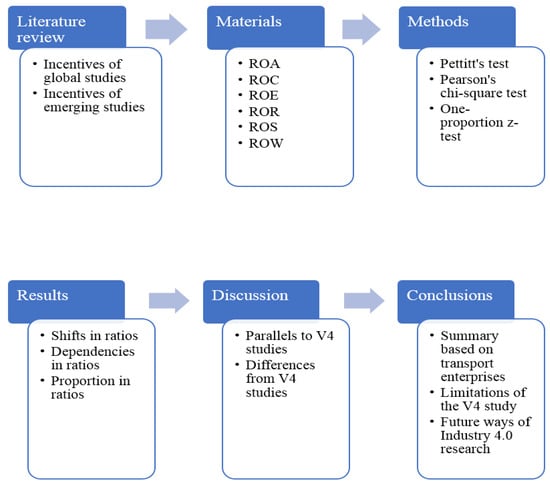
Figure 1.
Diagram of the structure. Source: own research.
2. Materials and Methods
These methodological steps were followed:
- Choice of region and period
The V4 region was selected as a group of four countries for the analysis. The first reason was the similar historical, political, and economic development of Czechia, Hungary, Poland, and Slovakia [53]. All countries belong between emerging markets and Central European Countries. Secondly, it was focused on transport enterprises and targeted to deliver a cross-country study, not only an investigation of one country. Mazanec [2] proves that Visegrad Group provides relevant background to assess the business performance of the transport sector and that it is possible to use these countries as the entire region.
The provided investigation is a fraction of comprehensive research that focuses on the implementation framework of Industry 4.0. This part assesses profitability in an individual sector within the V4 region before and during the COVID-19 pandemic, including the consequences of Industry 4.0 during the crisis. Previous research confirms the striking effect of smart sensors as tools of I4.0 individually to balance the profit of Czech, Hungarian, Polish, and Slovak enterprises [54]. That is how the period 2016–2021 was chosen. Molendowski et al. [55] also confirm this period to justify the Industry 4.0 concept. The research will be followed by an extension and analysis of the post-COVID-19 period, 2022–2023, to indicate changes caused by overcoming the crisis.
- 2.
- Creation and structure of a sample
The data was gained from the ORBIS database, which is provided by Bureau van Dijk. The database supplies information on more than 400 million large-scale private and public enterprises [56]. It was focused only on enterprises from NACE H, specifically, H.49 Land transport and transport via pipelines, H.50 Water transport, and H.51 Air transport. The origin set contained missing cases because of various strict legislative rules for accounting [57]. This fact caused an unbalanced sample according to countries. But the data was proven by national financial authorities when included in the ORBIS database. Leys et al. [58] recommend following a two-step procedure to deal with outliers. First, it is necessary to detect the possible candidates by using appropriate quantitative tools. Then, to manage outliers and decide whether to keep, remove, or recode these values based on qualitative information. In this exploration, the outliers were not removed to show a relevant sample, reflecting the actual situation in the transport sector during the analyzed period. Thus, the final sample from the V4 region included 159 Czech enterprises, 48 Hungarian enterprises, 8 Polish enterprises, and 319 Slovak enterprises. Together, 534 enterprises were available to compute all the chosen ratios of profitability. In addition, 332 selected enterprises have applied Industry 4.0, and 202 selected enterprises have not applied Industry 4.0 within the transport sector.
The classification shown in Table 2 is based on the ORBIS database. To be categorized as a medium, large, or very large enterprise, an enterprise must satisfy the requirements shown in the table. If not, the company was categorized as a small enterprise [59].

Table 2.
The classification according to the ORBIS database. Source: Blazek et al. [59].
Table 3 covers the structure of the final sample based on ORBIS classification criteria.

Table 3.
Sampling according to the size. Source: own research.
- 3.
- Choice of profitability ratios
This article focused on the profitability of transport enterprises. Six rations were selected to gain a comprehensive spectrum of the mentioned area. Table 4 involves these indicators, the algorithm of the calculation, and the abbreviation used. All indicators were computed with earnings before tax (EBT) because of the use of enterprises from different countries [60].

Table 4.
Selected profitability ratios. Source: own research.
- 4.
- Disclosure of a shift
Behavioural economics has led to a new way of looking at economics and finance [73]. Thus, the unusual assessment of profitability ratios by time series was used. A practical problem in time-ordered observations is looking for statistical techniques for gradual and/or abrupt changes in data distribution over time [74,75]. The process of identifying an abrupt change, usually due to distributional or structural change, is called change-point detection, where change-point refers to a period in which the behaviour of observations somehow changes. Gradual changes are, however, considered smooth departures from past norms [75]. Many methods have been recommended for trend detection and change-point detection. Militino et al. [75] summarise potential methods for both groups (Figure 2).
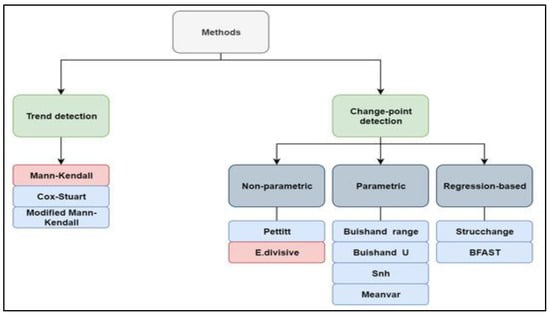
Figure 2.
Diagram of the considered trend and change-point detection methods. Source: Militino et al. [75].
The pink boxes in Figure 2 highlight the available methods for univariate and multivariate settings. Musa et al. [76] note that multivariate and panel data are mostly used to investigate the temporal evolution of different units of the same sector or market, characterised by an extensive cross-sectional structure across several periods. The panel format of data allows for the analysis of time series for every entity in a cross-sectional selection. Multivariable analyses use more sophisticated statistical methods than univariable analyses. But we have realised univariate solutions in this investigation. In addition, this research focuses only on finding change points (specific shifts), not gradual changes. Assume a situation where there is a single change-point in . Change-point detection methods look for a possible time such that where and are the distributions of and respectively. In this case, the null hypothesis claims that the distribution of does not change over time, while the alternative hypothesis assumes a change in the distribution of at time [75].
The normal distribution was not tested for univariate in the development of profitability ratios for every enterprise in the sample. That is how the nonparametric sign test (Pettitt’s test) was used to detect shifts with the 100,000 Monte Carlo simulations.
This test is based on Mann–Whitney two-sample test and its statistic is defined as:
Under the null hypothesis and for each , the distribution of is symmetric around zero with . It is expected to have large values for when there is a shift in data. Considering continuous observations, it is
where is the corresponding rank of the data point [75,77]. The approximate p-value is
and the value of provided by equation 1 is considered the most probable change point [78]. Positive and negative sights were tested for each enterprise. The analysis allows for formulating hypotheses as follows:
Hypothesis 0 (H0).
ROA, ROC, ROE, ROS, ROR, and ROW are homogeneous.
Hypothesis 1 (H1).
There is a date at which there is a positive (or negative) shift in the ROA, ROC, ROE, ROS, ROR, and ROW.
The values of the individual terms of the observed time series (ROA, ROC, ROE, ROS, ROR, and ROW) reflect only the natural variability of the studied variable. They are unaffected by external factors if one cannot reject the null hypothesis. If one can reject the null hypothesis, the implication is that there is a cause that has affected the development of ROA, ROC, ROE, ROS, ROR, and ROW in a positive or negative direction. In this case, the application of Industry 4.0 is discussed as an influencing factor.
- 5.
- Confirmation of a dependency
The shifts in the development of profitability ratios were detected, and then the dependency between two nominal variables was tested. The Pearson chi-square () test determines the existence or non-existence of independence between two variables [79]. It was run to identify the dependency between a shift in profitability (positive, negative, or no shift) and applying Industry 4.0 (yes or no). The basic idea underlying this is to compare the observed data values with the expected values if the prerequisites are met. The assumption of 80% of expected observations must be equal to or higher than value 5, and the second assumption of all cells of expected counts must be higher than value 1 [80].
The following hypotheses were verified:
Hypothesis 0 (H0).
The variable shift in ROA (ROC, ROE, ROS, ROR, or ROW) and the variable applying Industry 4.0 are independent.
Hypothesis 2 (H2).
There is a link between the variable shift in ROA (ROC, ROE, ROS, ROR, or ROW) and the variable applying Industry 4.0.
In addition, contingency coefficients for nominal variables were calculated.
where is test statistic from Pearson test, is the number of total observations, is the number of rows, is the number of columns [59].
Musova et al. [81], Dzurikova and Zvarikova [82] set the limits for the strength of the contingency coefficients as follows:
computed coefficient weak link.
computed coefficient medium link.
computed coefficient strong link.
The significance of coefficients was also proven to rule out the possibility of randomness of dependency in the used sample. The hypotheses for testing the significance of coefficients were as follows:
Hypothesis 0 (H0).
Computed coefficient is not statistically significant.
Hypothesis 3 (H3).
Computed coefficient is statistically significant.
- 6.
- Confirmation of a proportion
This part extends the research of Durana and Valaskova [54] to confirm a positive shift in a specific proportion of enterprises that applied Industry 4.0 through the used sample. It used the same methodology as in the mentioned research (one-proportion z-test) for ROA, ROC, ROE, ROS, ROR, and ROW.
Svabova et al. [83] noted that the null hypothesis was that the proportion of character in the population was equal to the constant (a test proportion). The alternative hypothesis in this exploration was that the proportion of character was greater than the chosen constant. The proportion occurred in the population at a higher rate than was assumed.
An assumption of the -test is that the size of the sample must be sufficiently large while considering the occurrence of the required character within it. The fulfilment of this assumption is very important to use the approximation of the distribution of the test statistics using the normal distribution. The sample is large enough if:
where:
where is the number of enterprises with positive shifts in the chosen profitability ratios and is the total range of the used sample.
The test statistic is defined as:
The test statistic may be greater than the standard normal distribution z2α for the upper-tailed hypothesis. Thus, one should reject the null hypothesis and accept the alternative hypothesis. The test proportion π0 was set at level 0.25. This meant that it should have been a derived conclusion for 25% of transport enterprises in the V4 region.
The percentage volume was determined because of a recent conclusion at a global level that the four technology groups of Industry 4.0 technologies (artificial vision and artificial intelligence, additive manufacturing and robotics, big data and advanced analytics, and the Internet of Things) may contribute to improving efficiency by an average of 15–25% in the processes where they are integrated within enterprises [84]. This research may add that Industry 4.0 is successful not only in efficiency but also in profitability.
The hypotheses for testing the significance of coefficients were as follows:
Hypothesis 0 (H0).
25% of enterprises involved in Industry 4.0 had positive shifts in ROA (ROC, ROE, ROS, ROR, or ROW).
Hypothesis 4 (H4).
More than 25% of enterprises involved in Industry 4.0 had positive shifts in ROA (ROC, ROE, ROS, ROR, or ROW).
3. Results
Firstly, descriptive characteristics (maximum, minimum, mean, standard deviation, and median) for each ratio and each year were calculated (Table 5).

Table 5.
Descriptive statistics of transport enterprises. Source: own research.
Secondly, Pettit’s test was run to identify shifts in all profitability ratios from 2016–2021. Figure 3 sums up the number of enterprises with specific categories of shifts for the sample of transport enterprises. The computed -values of the individual tests are demonstrated in the next sections of this chapter.
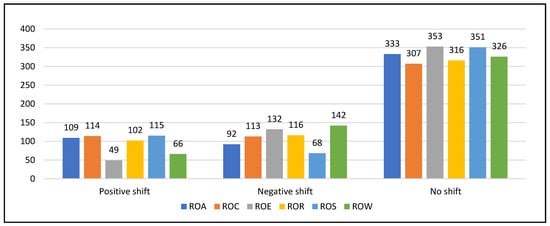
Figure 3.
The number of transport enterprises according to shifts in profitability during 2016–2021. Source: own research.
It was tested for upper and lower alternative hypotheses with 100,000 Monte Carlo simulations, and the following hypotheses were formulated for ROA for each enterprise in the V4 region:
H0.
The development of ROA was homogeneous during 2016–2021.
H1a.
There is a date at which there is a positive (or negative) shift in the ROA.
If the computed -value is lower than the significance level alpha, one should reject the null hypothesis and accept the alternative hypothesis based on Figure 4 and Figure 5. One hundred and nine (109) transport enterprises with positive shifts in ROA were detected. Ninety-two (92) transport enterprises with a negative shift in ROA were identified. If the computed -value was greater than the significance level alpha, we could not reject the null hypothesis based on Figure 4 and Figure 5. Three hundred thirty-three (333) transport enterprises were classified with no shift in ROA if there was no positive or negative shift disclosed.
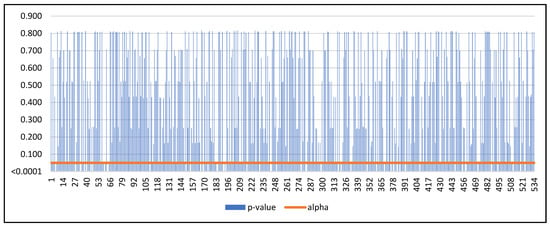
Figure 4.
Positive shift in ROA. Source: own research.
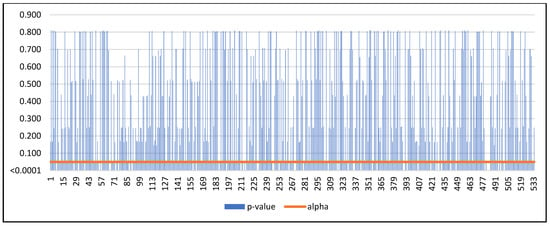
Figure 5.
Negative shift in ROA. Source: own research.
Then a crosstabulation based on shifts in ROA and the approach of the enterprises from the transport sector to Industry 4.0 was made (Table 6).

Table 6.
Shift in ROA and applying Industry 4.0. Source: own research.
It was tested for upper and lower alternative hypotheses with 100,000 Monte Carlo simulations, and the following hypotheses were formulated for ROC for each enterprise in the V4 region:
H0.
The development of ROC was homogeneous during 2016–2021.
H1b.
There is a date at which there is a positive (or negative) shift in the ROC.
Suppose the computed -value is lower than the significance level alpha. In that case, one should reject the null hypothesis and accept the alternative hypothesis based on Figure 6 and Figure 7. 114 transport enterprises with positive shifts in ROC were detected. One hundred and thirteen (113) transport enterprises with a negative shift in ROC were identified. If the computed -value was greater than the significance level alpha, we could not reject the null hypothesis based on Figure 6 and Figure 7. 307 transport enterprises were classified with no shift in ROC if there was no positive or negative shift disclosed.
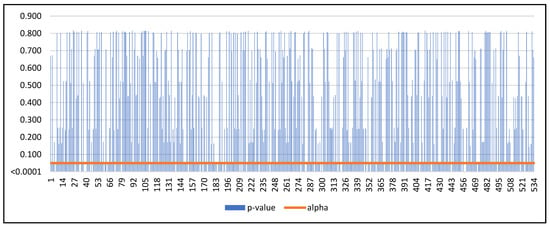
Figure 6.
Positive shift in ROC. Source: own research.
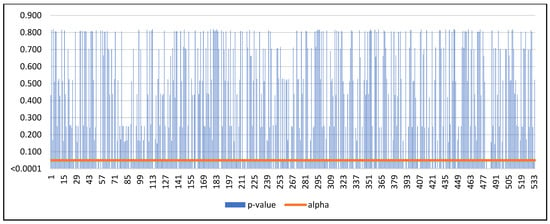
Figure 7.
Negative shift in ROC. Source: own research.
Then a crosstabulation based on shifts in ROC and the approach of the enterprises from the transport sector to Industry 4.0 was made (Table 7).

Table 7.
Shift in ROC and applying Industry 4.0. Source: own research.
It was tested for upper and lower alternative hypotheses with 100,000 Monte Carlo simulations, and the following hypotheses were formulated for ROE for each enterprise in the V4 region:
H0.
The development of ROE was homogeneous during 2016–2021.
H1c.
There is a date at which there is a positive (or negative) shift in the ROE.
Suppose the computed -value is lower than the significance level alpha. In that case, one should reject the null hypothesis and accept the alternative hypothesis based on Figure 8 and Figure 9. 49 transport enterprises with positive shifts in ROE were detected. One hundred and thirty-two (132) transport enterprises with a negative shift in ROE were identified. If the computed -value was greater than the significance level alpha, we could not reject the null hypothesis based on Figure 8 and Figure 9. 353 transport enterprises were classified with no shift in ROE if there was no positive or negative shift disclosed.
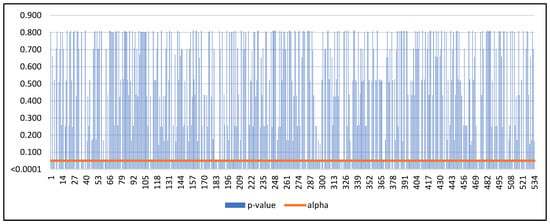
Figure 8.
Positive shift in ROE. Source: own research.
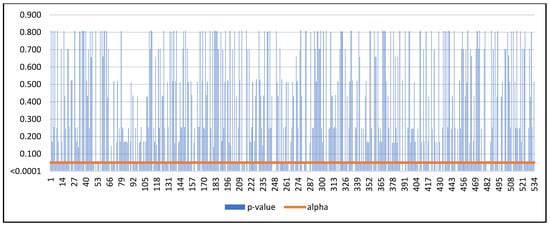
Figure 9.
Negative shift in ROE. Source: own research.
Then a crosstabulation based on shifts in ROE and the approach of the enterprises from the transport sector to Industry 4.0 was made (Table 8).

Table 8.
Shift in ROE and applying Industry 4.0. Source: own research.
It was tested for upper and lower alternative hypotheses with 100,000 Monte Carlo simulations, and the following hypotheses were formulated for ROR for each enterprise in the V4 region:
H0.
The development of ROR was homogeneous during 2016–2021.
H1d.
There is a date at which there is a positive (or negative) shift in the ROR.
If the computed -value is lower than the significance level alpha, one should reject the null hypothesis and accept the alternative hypothesis based on Figure 10 and Figure 11. One hundred and two (102) transport enterprises with positive shifts in ROR were detected. One hundred and sixteen (116) transport enterprises with a negative shift in ROR were identified. If the computed -value was greater than the significance level alpha, we could not reject the null hypothesis based on Figure 10 and Figure 11. Three hundred and sixteen (316) transport enterprises were classified with no shift in ROR if there was no positive or negative shift disclosed.
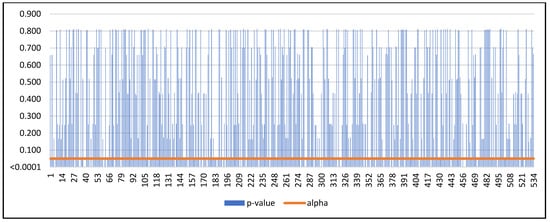
Figure 10.
Positive shift in ROR. Source: own research.
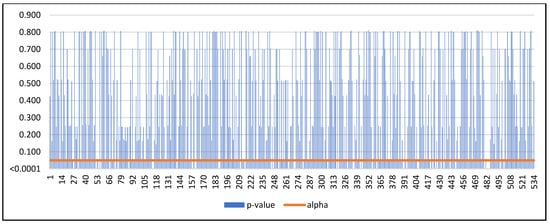
Figure 11.
Negative shift in ROR. Source: own research.
Then a crosstabulation based on shifts in ROR and the approach of the enterprises from the transport sector to Industry 4.0 was made (Table 9).

Table 9.
Shift in ROR and applying Industry 4.0. Source: own research.
It was tested for upper and lower alternative hypotheses with 100,000 Monte Carlo simulations, and the following hypotheses were formulated for ROS for each enterprise in the V4 region:
H0.
The development of ROS was homogeneous during 2016–2021.
H1e.
There is a date at which there is a positive (or negative) shift in the ROS.
If the computed -value is lower than the significance level alpha, one should reject the null hypothesis and accept the alternative hypothesis based on Figure 12 and Figure 13. One hundred fifteen (115) transport enterprises with positive shifts in ROS were detected. Sixty-eight (68) transport enterprises with a negative shift in ROS were identified. If the computed -value was greater than the significance level alpha, we could not reject the null hypothesis based on Figure 12 and Figure 13. Three hundred and fifty-one (351) transport enterprises were classified with no shift in ROS if there was no positive or negative shift disclosed.
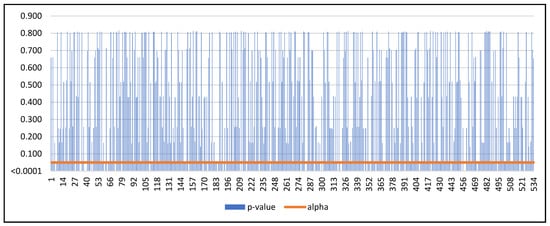
Figure 12.
Positive shift in ROS. Source: own research.

Figure 13.
Negative shift in ROS. Source: own research.
Then a crosstabulation based on shifts in ROS and the approach of the enterprises from the transport sector to Industry 4.0 was made (Table 10).

Table 10.
Shift in ROS and applying Industry 4.0. Source: own research.
It was tested for upper and lower alternative hypotheses with 100,000 Monte Carlo simulations, and the following hypotheses were formulated for ROW for each enterprise in the V4 region:
H0.
The development of ROW was homogeneous during 2016–2021.
H1f.
There is a date at which there is a positive (or negative) shift in the ROW.
If the computed -value is lower than the significance level alpha, one should reject the null hypothesis and accept the alternative hypothesis based on Figure 14 and Figure 15. Sixty-six (66) transport enterprises with positive shifts in ROW were detected. One hundred and forty-two (142) transport enterprises with a negative shift in ROW were identified. If the computed -value was greater than the significance level alpha, we could not reject the null hypothesis based on Figure 14 and Figure 15. Three hundred and twenty-six (326) transport enterprises were classified with no shift in ROW if there was no positive or negative shift disclosed.
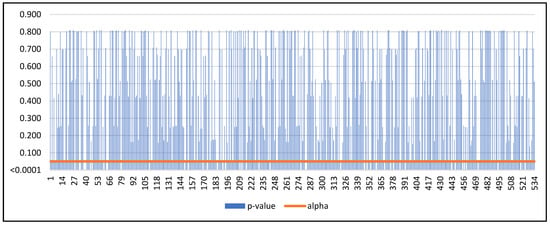
Figure 14.
Positive shift in ROW. Source: own research.
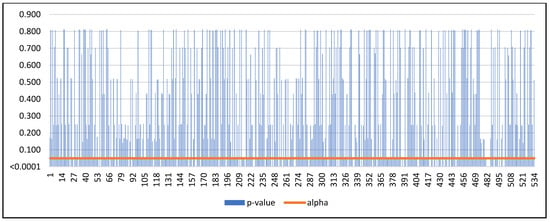
Figure 15.
Negative shift in ROW. Source: own research.
Then a crosstabulation based on shifts in ROW and the approach of the enterprises from the transport sector to Industry 4.0 was made (Table 11).

Table 11.
Shift in ROW and applying Industry 4.0. Source: own research.
Thirdly, the dependence of two variables from previous crosstabulations was tested by the Pearson chi-square test.
H0.
The variable shift in ROA (ROC, ROE, ROS, ROR, or ROW) and the variable applying Industry 4.0 are independent.
H2.
There is a link between the variable shift in ROA (ROC, ROE, ROS, ROR, or ROW) and the variable applying Industry 4.0.
If the computed -value is lower than the significance level alpha, one should reject the null hypothesis and accept the alternative hypothesis based on Table 12. It was proven that there is a significant dependency between a shift in ROA (ROC, ROE, ROS, ROR, or ROW) and applying I4.0.

Table 12.
The z-test for comparison of one proportion for SMEs. Source: own research.
After the test of independence, the strength of dependence was computed. Between a shift in ROA (ROC, ROE, ROS, ROR, or ROW) and applying I4.0, a medium dependency was identified based on the values of both coefficients (Table 13). The test of significance for the contingency coefficients was run.

Table 13.
Contingency coefficients. Source: own research.
H0.
Contingency coefficient (Cramer’s V) is not statistically significant.
H3.
Contingency coefficient (Cramer’s V) is statistically significant.
If the computed -value is lower than the significance level alpha, one should reject the null hypothesis and accept the alternative hypothesis based on Table 13. The contingency coefficient and Cramer’s V are statistically significant.
Finally, it was only focused on the percentage of enterprises with positive shifts in profitability ratios that applied Industry 4.0 through the sample used. To explore a sequel to applying I4.0 for transport enterprises, a z-test for one proportion was used.
H0.
25% of enterprises involved in Industry 4.0 had positive shifts in ROA (ROC, ROE, ROS, ROR, or ROW).
H4.
More than 25% of enterprises involved in Industry 4.0 had positive shifts in ROA (ROC, ROE, ROS, ROR, or ROW).
If the computed -value is lower than the significance level alpha, one should reject the null hypothesis and accept the alternative hypothesis based on Table 14. More than 25% of enterprises involved in Industry 4.0 had positive shifts in profitability ratios ROA, ROC, ROS, and ROR. It implies that Industry 4.0 may serve not only to balance the mentioned profitability ratios but also to increase them.

Table 14.
The z-test for ROA, ROC, ROR, and ROS. Source: own research.
But if the computed -value was greater than the significance level alpha, we could not reject the null hypothesis based on Table 15 for profitability ratios ROE and ROW.

Table 15.
The z-test for ROE and ROW. Source: own research.
4. Discussion
Our findings were first discussed to find parallels with the conclusions from studies in similar environments. Then, it was targeted at extending previous research by showing the dependencies between profitability and Industry 4.0 or additional factors within the transport sector.
The relevancy of common generalizations for enterprises from Czechia, Hungary, Poland, and Slovakia is aligned with the study by Didenko et al. [85]. They highlight that these countries belong to a similar cluster of socio-economic development. Then, the main findings may be discussed, namely that the positive consequences of Industry 4.0 for the V4 region were proven.
Nagy et al. [86] validate the critical role of Industry 4.0 in smart process planning provided by deep learning and virtual simulation algorithms, especially for industrial production. We validate the positive effect of components of I4.0 for transport enterprises. The individual analysis of the profitability of enterprises in the transport sector is undeniable. The significance of the mentioned sector was also determined by Michalkova [87]. The study marks the transport sector as crucial in the current economic situation. Honkova adds [88] that the transport sector plays a significant role in ensuring competitiveness and sustainable economic growth in Europe.
Habanik et al. [89] show the impact of Industry 4.0 on the selected macroeconomic indicators. We confirm the effect of I4.0 on the selected microeconomic indicators. Specifically, our study disclosed the influence on profitability ratios. This fact fits with the conclusion of Svabova et al. [90]. They set out that the source for these similarities among the values of profit levels of the enterprises in V4 countries arises not only from the economic situation in the countries but also from the economic situation in these enterprises.
Vrabel et al. [91] emphasize the need to deliver innovative technologies suitable for transport. Our findings support this approach with evidence-based results of significant dependency between shifts in ROA, ROC, ROE, ROS, ROR, or ROW and applying I4.0 based on a robust sample of transport enterprises.
This research extends the conclusions of Durana and Valaskova [54]. They analyze the same period but focus only on Slovak, Czech, Polish, and Hungarian SMEs applying smart sensors. But this study involves any tool of Industry 4.0, not only smart sensors. They prefer profit in absolute values to more unified profitability ratios from delivered research. In addition, the investigation was realized for every country in the region and proved individually that smart sensors balanced the earnings of the enterprises during the COVID-19 pandemic. Based on robust subsamples, it was identified that more than 80% of enterprises did not have a negative trend in how their earnings shifted during the six years. We extend the conclusion from individual countries to the whole region of countries in general. The development was evaluated by the Mann-Kendall trend test, and the proportion was tested by a z-test to compare one proportion. Our investigation added the direction of the shift to trend detection for all 534 businesses involved.
Kutac et al. [92] investigate the consequences of personnel cost growth on the profitability of transport enterprises in Czechia. We differ from this study in that it was not operating profit but EBT that was preferred for calculating ratios. It was focused on large road freight transport companies. We involve all kinds of transport (land, pipe, water, and air). Data from 25 businesses that met the requirement of being accessible for all years during the assessment period from 2014 to 2019 was used for the analysis. Our analysis provided a larger sample and had more robust implications. Return on assets within operating profit, return on equity within operating profit, and return on personnel costs within operating profit were calculated. They found that choosing transport companies in the years 2015–2016 resulted in a considerable decline in labor productivity as measured by sales per employee and decreased profit. This was due to rising human expenditures. Due to higher labor productivity and higher profits, the annual increase in personnel costs slowed down in 2017 and 2018. Despite another increase in personnel expenditures in 2019, the situation shifted, and profit and labor productivity rose. According to the analysis of these data, the increase in labor productivity in terms of sales per employee and profit growth in 2018 and 2019 was due to the rising cost of transportation, which included higher human expenditures. We analyzed similar indicators but extended them to about three more indicators (ROC, ROR, and ROS).
Czodorova and Gnap [93] investigate the effectiveness of the introduction of a quality management system according to the ISO 9001 standard in Slovak transport enterprises. It was observed from 2009 to 2020. Their case study showed that the implementation of a quality management system according to the ISO 9001 standard had a significant and positive impact not only on ROA but also on ROS performance. In addition, when compared to the period before they obtained ISO 9001 certification, there was a considerable improvement in their average values. Further research into the financial standing of transport businesses that already had an ISO 9001-compliant quality management system showed that all the values of the chosen indicators increased in 2020 during the COVID-19 pandemic. We add to this conclusion and the conclusion of Fulop et al. [94] that applications of Industry 4.0 may also have a positive impact on ROA and ROS performance and other profitability indicators. Fulop et al. [94] also use a case study to test the positive effect of the smart optimal method on the fuel supply of transport activity. They do not focus on specific profitability indicators but on overall efficiency. Based on the more cost-effective option, the approach created in this study helps make decisions about whether to refill at a farther but more affordable fuel station or at a closer but more expensive fuel station. The optimal fuel volume, or the precise volume required, including a safe quantity to cover stochastic situations, must then be ascertained. This feature of the optimization approach supports the best choices for the best stations and how much fuel to buy to lower fuel costs. Therefore, using this new approach as opposed to the drivers’ recent ad hoc individual decision-making leads to significant cost savings.
Korneta [95] discloses another positive impact on profitability compared to our study of the country in the V4 region. The influence of net promoter scores on Polish transport was assessed. Based on the smaller sample of 34 enterprises, the study verified a statistically significant and positive dependence between net promoter score and the three profitability variables (ROA, ROE, and ROS). We confirm the dependencies for the whole region with a larger sample and three more ratios. The Pearson correlation coefficient was run, and three profitability ratios were calculated, not from EBT as we did. But from the net result and earnings before interest, tax, depreciation, and amortization (EBITDA). We support the Pearson correlation coefficient with Cramer’s V.
5. Conclusions
This article aimed to confirm the positive sequel of applying Industry 4.0 to chosen indicators of profitability in the transport sector. Shifts in ROA, ROC, ROE, ROR, ROS, and ROW in the sample of 534 enterprises were detected during 2016–2021. No shifts were mostly detected, but negative and positive shifts were also identified by the test of homogeneity of the time series. Disclosed categories created a variable that was labeled shift in selected ratios. This variable was related to the variable application of Industry 4.0 by the chi-square test. The middle and significant dependency between Industry 4.0 and shifts in all profitability was proven by tests and contingency coefficients. Based on the used sample and one sample proportion test, more than 25% of transport enterprises involved in Industry 4.0 had positive shifts in ROA, ROC, ROS, and ROR. This fact was not confirmed for ROE and ROW. The research may be replicated in other countries or for other evaluation parameters.
The research had limitations, too. The first was an unbalanced sample of enterprises from countries in the Visegrad Group. Secondly, it was focused on only one sector and the period 2016–2021. In addition, shifts in ROA, ROC, ROE, ROR, ROS, and ROW were detected only with Pettit’s test. Thus, future research may extend samples from Hungary and Poland to gain a more balanced sample and calculate profitability ROI (return on investment). Then cover all relevant sectors connected with Industry 4.0 and its tools. Finally, map the post-COVID-19 period of 2022–2023.
Author Contributions
Conceptualization, P.D.; methodology, P.D.; software, P.D.; validation, M.B. and R.B.; formal analysis, P.D.; investigation, P.D.; resources, J.H.; data curation, M.B. and R.B.; writing—original draft preparation, P.D.; writing—review and editing, M.B., R.B. and J.H.; visualization, P.D.; supervision, M.B., R.B. and J.H.; project administration, M.B. and P.D.; funding acquisition, P.D. All authors have read and agreed to the published version of the manuscript.
Funding
This research received no external funding.
Data Availability Statement
The data presented in this study are available upon request from the corresponding author.
Acknowledgments
This research was financially supported by the project NFP313011BWN6 “The implementation framework and business model of the Internet of Things, Industry 4.0 and smart transport”.
Conflicts of Interest
The authors declare no conflict of interest.
References
- Kliestik, T.; Novak Sedlackova, A.; Bugaj, M.; Novak, A. Stability of profits and earnings management in the transport sector of Visegrad countries. Oeconomia Copernic. 2022, 13, 475–509. [Google Scholar] [CrossRef]
- Zvarikova, K.; Gajanova, L.; Higgins, M. Adoption of delivery apps during the COVID-19 crisis: Consumer perceived value, behavioral choices, and purchase intentions. J. Self-Gov. Manag. Econ. 2022, 10, 69–81. [Google Scholar]
- Mazanec, J. The Impact of working capital management on corporate performance in small–medium enterprises in the Visegrad Group. Mathematics 2022, 10, 951. [Google Scholar] [CrossRef]
- Michalkova, L.; Cepel, M.; Valaskova, K.; Vincurova, Z. Earnings quality and corporate life cycle before the crisis. A study of transport companies across Europe. Amfiteatru Econ. 2022, 24, 782–796. [Google Scholar] [CrossRef]
- Nagy, M.; Lazaroiu, G. Computer vision algorithms, remote sensing data fusion techniques, and mapping and navigation tools in the Industry 4.0-based Slovak automotive sector. Mathematics 2022, 10, 3543. [Google Scholar] [CrossRef]
- Valaskova, K.; Nagy, M.; Zabojnik, S.; Lazaroiu, G. Industry 4.0 wireless networks and cyber-physical smart manufacturing systems as accelerators of value-added growth in Slovak exports. Mathematics 2022, 10, 2452. [Google Scholar] [CrossRef]
- Kostrzewski, M.; Sompolski, K.; Krolikowski, T. How profitable is it to apply Industry 4.0 solutions in blister factories? Procedia Comput. Sci. 2022, 207, 3281–3289. [Google Scholar] [CrossRef]
- Mustapic, M.; Trstenjak, M.; Greguric, P.; Opetuk, T. Implementation and use of digital, green and sustainable technologies in internal and external transport of manufacturing companies. Sustainability 2023, 15, 9557. [Google Scholar] [CrossRef]
- Gordon, S. Computer vision algorithms, vehicle navigation and remote sensing technologies, and smart traffic planning and analytics in urban transportation systems. Contemp. Read. Law Soc. Justice 2022, 14, 9–24. [Google Scholar] [CrossRef]
- Kostrzewski, M.; Abdelatty, Y.; Eliwa, A.; Nader, M. Analysis of modern vs. conventional development technologies in transportation—The case study of a last-mile delivery process. Sensors 2022, 22, 9858. [Google Scholar] [CrossRef]
- Nica, E.; Popescu, G.H.; Poliak, M.; Kliestik, T.; Sabie, O.-M. Digital twin simulation tools, spatial cognition algorithms, and multi-sensor fusion technology in sustainable urban governance networks. Mathematics 2023, 11, 1981. [Google Scholar] [CrossRef]
- Bradford, J. The geopolitics of smart urban governance: 3D space mapping algorithms, digital twin simulation and virtual reality modeling tools, and cloud computing and image recognition technologies. Geopolit. Hist. Int. Relat. 2022, 14, 88–103. [Google Scholar] [CrossRef]
- Cug, J.; Suler, P.; Taylor, E. Digital twin-based cyber-physical production systems in immersive 3D environments: Virtual modeling and simulation tools, spatial data visualization techniques, and remote sensing technologies. Econ. Manag. Financ. Mark. 2022, 17, 82–96. [Google Scholar] [CrossRef]
- Rowland, Z.; Cug, J.; Nica, E. The geopolitics of smart city digital twins: Urban sensing and immersive virtual technologies, spatio-temporal fusion algorithms, and visualization modeling tools. Geopolit. Hist. Int. Relat. 2022, 14, 56–71. [Google Scholar] [CrossRef]
- Novak, P.; Vyskocil, J. Digitalized automation engineering of Industry 4.0 production systems and their tight cooperation with digital twins. Processes 2022, 10, 404. [Google Scholar] [CrossRef]
- Fedorko, G.; Molnar, V.; Vasil, M.; Salai, R. Proposal of digital twin for testing and measuring of transport belts for pipe conveyors within the concept Industry 4.0. Measurement 2021, 174, 108978. [Google Scholar] [CrossRef]
- Liu, B.; Han, C.; Liu, X. Vehicle artificial intelligence system based on intelligent image analysis and 5G network. Int. J. Wireless Inf. Netw. 2023, 30, 86–102. [Google Scholar] [CrossRef]
- Balica, R.-S.; Cutitoi, A.-C. Ethical artificial intelligence in smart mobility technologies: Autonomous driving algorithms, geospatial data mining tools, and ambient sound recognition software. contemp. Read. Law Soc. Justice 2022, 14, 64–81. [Google Scholar] [CrossRef]
- Hancock, K. Cognitive artificial intelligence and predictive modeling algorithms, virtual navigation and geospatial mapping tools, and remote sensing data fusion techniques in the immersive metaverse environment. J. Self-Gov. Manag. Econ. 2022, 10, 40–55. [Google Scholar] [CrossRef]
- Newell, M. The social justice of intelligent transportation systems: Deep learning-based autonomous driving technologies, cooperative navigation algorithms, and vehicle and pedestrian detection tools. Contemp. Read. Law Soc. Justice 2022, 14, 9–26. [Google Scholar] [CrossRef]
- Pera, A. The moral decision-making capacity of autonomous mobility technologies: Route planning algorithms, simulation modeling tools, and intelligent traffic monitoring systems. Contemp. Read. Law Soc. Justice 2022, 14, 136–153. [Google Scholar] [CrossRef]
- Mhlanga, D. Artificial Intelligence in the Industry 4.0, and its impact on poverty, innovation, infrastructure development, and the sustainable development goals: Lessons from emerging economies? Sustainability 2021, 13, 5788. [Google Scholar] [CrossRef]
- Ferreira, A.M.A.; Azevedo, L.J.d.M.d.; Estrella, J.C.; Delbem, A.C.B. Case studies with the Contiki-NG Simulator to design strategies for sensors’ communication optimization in an IoT-Fog ecosystem. Sensors 2023, 23, 2300. [Google Scholar] [CrossRef]
- Valaskova, K.; Horak, J.; Lazaroiu, G. Socially responsible technologies in autonomous mobility systems: Self-driving car control algorithms, virtual data modeling tools, and cognitive wireless sensor networks. Contemp. Read. Law Soc. Justice 2022, 14, 172–188. [Google Scholar] [CrossRef]
- Kovacova, M.; Olah, J.; Popp, J.; Nica, E. The algorithmic governance of autonomous driving behaviors: Multi-sensor data fusion, spatial computing technologies, and movement tracking tools. Contemp. Read. Law Soc. Justice 2022, 14, 27–45. [Google Scholar] [CrossRef]
- Lazaroiu, G.; Androniceanu, A.; Grecu, I.; Grecu, G.; Negurița, O. Artificial intelligence-based decision-making algorithms, Internet of Things sensing networks, and sustainable cyber-physical management systems in big data-driven cognitive manufacturing. Oeconomia Copernic. 2022, 13, 1047–1080. [Google Scholar] [CrossRef]
- Priyanka, E.B.; Maheswari, C.; Thangavel, S. A smart-integrated IoT module for intelligent transportation in oil industry. Int. J. Numer. Model. Electron. Netw. Devices Fields 2021, 34, e2731. [Google Scholar] [CrossRef]
- Karmanska, A. Internet of Things in the accounting field–benefits and challenges. Oper. Res. Decis. 2021, 31, 23–39. [Google Scholar] [CrossRef]
- Ayimba, C.; Cislaghi, V.; Quadri, C.; Casari, P.; Mancuso, V. Copy-CAV: V2X-enabled wireless towing for emergency transport. Comput. Commun. 2023, 205, 87–96. [Google Scholar] [CrossRef]
- Morley, N. Autonomous vehicle ethics in networked transport systems: Spatial cognition algorithms, mobility data processing tools, and deep learning-based sensing technologies. Contemp. Read. Law Soc. Justice 2022, 14, 82–99. [Google Scholar] [CrossRef]
- Kliestik, T.; Musa, H.; Machova, V.; Rice, L. Remote sensing data fusion techniques, autonomous vehicle driving perception algorithms, and mobility simulation tools in smart transportation systems. Contemp. Read. Law Soc. Justice 2022, 14, 137–152. [Google Scholar] [CrossRef]
- Poliak, M.; Jurecki, R.; Buckner, K. Autonomous vehicle routing and navigation, mobility simulation and traffic flow prediction tools, and deep learning object detection technology in smart sustainable urban transport systems. Contemp. Read. Law Soc. Justice 2022, 14, 25–40. [Google Scholar] [CrossRef]
- Bratu, S. Autonomous vehicle perception sensor data, motion planning and object recognition algorithms, and virtual simulation modeling tools in smart sustainable intelligent transportation systems. Contemp. Read. Law Soc. Justice 2022, 14, 153–168. [Google Scholar] [CrossRef]
- Griffin, K.; Krastev, V. Smart traffic planning and analytics, autonomous mobility technologies, and algorithm-driven sensing devices in urban transportation systems. Contemp. Read. Law Soc. Justice 2021, 13, 65–78. [Google Scholar]
- Castro, H.; Costa, F.; Ferreira, T.; Avila, P.; Cruz-Cunha, M.; Ferreira, L.; Putnik, G.D.; Bastos, J. Data science for Industry 4.0 and sustainability: A survey and analysis based on open data. Machines 2023, 11, 452. [Google Scholar] [CrossRef]
- Zvarikova, K.; Horak, J.; Downs, S. Digital twin algorithms, smart city technologies, and 3D spatio-temporal simulations in virtual urban environments. Geopolit. Hist. Int. Relat. 2022, 14, 139–154. [Google Scholar] [CrossRef]
- Peters, E. Urban computing algorithms, virtual sensor networks, and geospatial data visualization in digital twin cities. Geopolit. Hist. Int. Relat. 2022, 14, 75–90. [Google Scholar] [CrossRef]
- Peters, E. Big Geospatial data analytics, connected vehicle technologies, and visual perception and sensor fusion algorithms in smart transportation networks. Contemp. Read. Law Soc. Justice 2022, 14, 73–88. [Google Scholar] [CrossRef]
- Townsend, J. Interconnected sensor networks and machine learning-based analytics in data-driven smart sustainable cities. Geopolit. Hist. Int. Relat. 2021, 13, 31–41. [Google Scholar] [CrossRef]
- Nikitas, A.; Michalakopoulou, K.; Njoya, E.T.; Karampatzakis, D. Artificial intelligence, transport and the smart city: Definitions and dimensions of a new mobility era. Sustainability 2020, 12, 2789. [Google Scholar] [CrossRef]
- da Silva, M.R.F.; Agostino, I.R.S.; Frazzon, E.M. Integration of machine learning and simulation for dynamic rescheduling in truck appointment systems. Simul. Model. Pract. Theory 2023, 125, 102747. [Google Scholar] [CrossRef]
- Beckett, S. Machine and deep learning technologies, location tracking and obstacle avoidance algorithms, and cognitive wireless sensor networks, in intelligent transportation planning and engineering. Contemp. Read. Law Soc. Justice 2022, 14, 41–56. [Google Scholar] [CrossRef]
- Hopkins, E. Machine learning tools, algorithms, and techniques in retail business operations: Consumer perceptions, expectations, and habits. J. Self-Gov. Manag. Econ. 2022, 10, 43–55. [Google Scholar]
- Duncan, G. Deep learning-based ethical judgments in connected vehicle technologies: Route planning algorithms, spatial data visualization tools, and real-time predictive analytics. Contemp. Read. Law Soc. Justice 2022, 14, 46–63. [Google Scholar] [CrossRef]
- Zvarikova, K.; Rowland, Z.; Nica, E. Multisensor fusion and dynamic routing technologies, virtual navigation and simulation modeling tools, and image processing computational and visual cognitive algorithms across web3-powered metaverse worlds. Anal. Metaphys. 2021, 21, 125–141. [Google Scholar] [CrossRef]
- Ionescu, L. Machine learning-based decision-making systems, cloud computing and blockchain technologies, and big data analytics algorithms in accounting and auditing. Econ. Manag. Financ. Mark. 2022, 17, 9–26. [Google Scholar] [CrossRef]
- Cepa, J.J.; Pavon, R.M.; Alberti, M.G.; Ciccone, A.; Asprone, D. A Review on the implementation of the BIM methodology in the operation maintenance and transport infrastructure. Appl. Sci. 2023, 13, 3176. [Google Scholar] [CrossRef]
- Novak, A.; Novak Sedlackova, A.; Vochozka, M.; Popescu, G.H. Big data-driven governance of smart sustainable intelligent transportation systems: Autonomous driving behaviors, predictive modeling techniques, and sensing and computing technologies. Contemp. Read. Law Soc. Justice 2022, 14, 100–117. [Google Scholar] [CrossRef]
- Perkins, J. Extended reality and geospatial mapping technologies, behavioral predictive and mobile location analytics, and motion planning and object recognition algorithms in immersive hyper-connected virtual spaces. J. Self-Gov. Manag. Econ. 2022, 10, 23–39. [Google Scholar] [CrossRef]
- Perkins, J. Artificial moral agents in big data-driven transportation systems: Autonomous vehicle perception sensors, virtual simulation algorithms, and geospatial mapping tools. Contemp. Read. Law Soc. Justice 2022, 14, 118–135. [Google Scholar] [CrossRef]
- Konecny, V.; Jaskiewicz, M.; Downs, S. Motion planning and object recognition algorithms, vehicle navigation and collision avoidance technologies, and geospatial data visualization in network connectivity systems. Contemp. Read. Law Soc. Justice 2022, 14, 89–104. [Google Scholar] [CrossRef]
- Dawson, A. Robotic wireless sensor networks, big data-driven decision-making processes, and cyber-physical system-based real-time monitoring in sustainable product lifecycle management. Econ. Manag. Financ. Mark. 2021, 16, 95–105. [Google Scholar] [CrossRef]
- Roszko-Wojtowicz, E.; Danska-Borsiak, B.; Grzelak, M.M.; Plesniarska, A. In search of key determinants of innovativeness in the regions of the Visegrad group countries. Oeconomia Copernic. 2022, 13, 1015–1045. [Google Scholar] [CrossRef]
- Durana, P.; Valaskova, K. The nexus between smart sensors and the bankruptcy protection of SMEs. Sensors 2022, 22, 8671. [Google Scholar] [CrossRef]
- Molendowski, E.; Nawracaj-Grygiel, K.; Ulbrych, M. The competitiveness of manufacturing in Poland and the other V4 countries against the backdrop of digital transformation challenges. East. Eur. J. Trans. Relat. 2022, 6, 7–22. [Google Scholar] [CrossRef]
- Gajdosikova, D.; Lazaroiu, G.; Valaskova, K. How particular firm-specific features influence corporate debt level: A case study of Slovak enterprises. Axioms 2023, 12, 183. [Google Scholar] [CrossRef]
- Ashouri, S.; Suominen, A.; Hajikhani, A.; Pukelis, L.; Schubert, T.; Turkeli, S.; Van Beers, C.; Cunningham, S. Indicators on firm level innovation activities from web scraped data. Data Brief 2022, 42, 108246. [Google Scholar] [CrossRef]
- Leys, C.; Delacre, M.; Mora, Y.L.; Lakens, D.; Ley, C. How to classify, detect, and manage univariate and multivariate outliers, with emphasis on pre-registration. Int. Rev. Soc. Psychol. 2019, 32, 5, 1–10. [Google Scholar] [CrossRef]
- Blazek, R.; Durana, P.; Michulek, J.; Blazekova, K. Does the size of the business still matter, or is profitability under new management, by order of the COVID-19? J. Risk Financ. Manag. 2023, 16, 219. [Google Scholar] [CrossRef]
- Kliestik, T.; Hrosova, L.; Valaskova, K.; Svabova, L. Do firm in the tourism sector manage earnings? The case of the V4 countries. J. Tour. Serv. 2022, 13, 120–136. [Google Scholar] [CrossRef]
- Herman, E.; Zsido, K.-E.; Fenyves, V. Cluster analysis with k-mean versus k-medoid in financial performance evaluation. Appl. Sci. 2022, 12, 7985. [Google Scholar] [CrossRef]
- Sajnog, A.; Rogozinska-Pawelczyk, A. Executive compensation and the financial performance of Polish listed companies from the corporate governance perspective. Equilib. Q. J. Econ. Econ. Policy 2022, 17, 459–480. [Google Scholar] [CrossRef]
- Bayaraa, B. Financial performance determinants of organizations the case of Mongolian companies. J. Compet. 2017, 9, 22–33. [Google Scholar] [CrossRef]
- Popescu, A.; Marcuta, A.; Tindeche, C.; Angelescu, C.; Marcuta, L. Profit and profitability of the commercial companies dealing with dairy farming. Sci. Pap. Ser. Manag. Econ. Eng. Agric. Rural Dev. 2020, 20, 447–460. [Google Scholar]
- Nejjari, Z.; Aamoum, H. The Impact of intellectual capital on profitability, market value, productivity, and return on equity: Empirical evidence from Moroccan ICT firms. J. Knowl. Econ. 2022, 14, 1734–1748. [Google Scholar] [CrossRef]
- Mudzakar, M.K. The effect of return on asset, return on equity, earning per share, and price earning ratio toward stock return (empirical study of transportation). Turk. J. Comput. Math. Educ. 2021, 12, 387–392. [Google Scholar]
- Karanovic, G.; Stambuk, A.; Jagodic, D. Profitability performance undercapital structure and other company characteristics: An Empirical study of Croatian hotel industry. Zbor. Veleucil. U Rijeci 2020, 8, 227–242. [Google Scholar] [CrossRef]
- Kutlu, L.; Tran, K.C.; Tsionas, M.G. A time-varying true individual effects model with endogenous regressors. J. Econom. 2019, 211, 539–559. [Google Scholar] [CrossRef]
- Miskufova, M.; Jencova, S.; Petruska, I. Dependence of ROS on financial indicators using threshold regression models. Ekon. Manaz. Spektrum 2022, 16, 49–60. [Google Scholar]
- Stefko, R.; Vasanicova, P.; Jencova, S.; Pachura, A. Management and economic sustainability of the Slovak industrial companies with medium energy intensity. Energies 2021, 14, 267. [Google Scholar] [CrossRef]
- Barkai, S. Declining labor and capital shares. J. Financ. 2020, 75, 2421–2463. [Google Scholar] [CrossRef]
- Vojinovic, Z.; Milutinovic, S.; Sertic, D.; Lekovic, B. Determinants of sustainable profitability of the Serbian insurance industry: Panel data investigation. Sustainability 2022, 14, 5190. [Google Scholar] [CrossRef]
- Kristofik, P.; Medzihorsky, J.; Musa, H. Capital structure and its determinants—A comparison of European top-rated CSR and other companies. J. Risk Financ. Manag. 2022, 15, 325. [Google Scholar] [CrossRef]
- Kliestik, T.; Valaskova, K.; Nica, E.; Kovacova, M.; Lazaroiu, G. Advanced methods of earnings management: Monotonic trends and change-points under spotlight in the Visegrad countries. Oeconomia Copernic. 2020, 11, 371–400. [Google Scholar] [CrossRef]
- Militino, A.F.; Moradi, M.; Ugarte, M.D. On the performances of trend and change-point detection methods for remote sensing data. Remote Sens. 2020, 12, 1008. [Google Scholar] [CrossRef]
- Musa, H.; Musova, Z.; Natorin, V.; Lazaroiu, G.; Boda, M. Comparison of factors influencing liquidity of European Islamic and conventional banks. Oeconomia Copernic. 2021, 12, 375–398. [Google Scholar] [CrossRef]
- Pettitt, A.N. A non-parametric approach to the change-point problem. J. R. Stat. Soc. C Appl. Stat. 1979, 28, 126–135. [Google Scholar] [CrossRef]
- Valaskova, K.; Gavurova, B.; Durana, P.; Kovacova, M. Alter ego only four times? The case study of business profits in the Visegrad group. E M Econ. Manag. 2020, 23, 101–119. [Google Scholar] [CrossRef]
- Kliestik, T.; Blazek, R.; Belas, J. CEO monitoring and accounting record manipulation: Evidence from Slovak agriculture companies. Econ. Sociol. 2022, 15, 204–218. [Google Scholar] [CrossRef]
- Valaskova, K.; Kliestik, T.; Svabova, L.; Adamko, P. Financial risk measurement and prediction modelling for sustainable development of business entities using regression analysis. Sustainability 2018, 10, 2144. [Google Scholar] [CrossRef]
- Musova, Z.; Musa, H.; Drugdova, J.; Lazaroiu, G.; Alayasa, J. Consumer attitudes towards new circular models in the fashion industry. J. Compet. 2021, 13, 111–128. [Google Scholar] [CrossRef]
- Dzurikova, S.; Zvarikova, K. Do age cohort and personal income matter in green marketing? The case of the Slovak Republic. Ekon. Manaz. Spektrum 2023, 17, 54–62. [Google Scholar] [CrossRef]
- Svabova, L.; Durana, P.; Durica, M. Descriptive and Inductive Statistics, 1st ed.; University of Zilina: Zilina, Slovakia, 2022; pp. 318–331. [Google Scholar]
- Arana-Landin, G.; Uriarte-Gallastegi, N.; Landeta-Manzano, B.; Laskurain-Iturbe, I. The contribution of lean management—Industry 4.0 technologies to improving energy efficiency. Energies 2023, 16, 2124. [Google Scholar] [CrossRef]
- Didenko, I.; Valaskova, K.; Artyukhov, A.; Lyeonov, S.; Vasa, L. Quality of scientific activity as a determinant of socio-economic development. Econ. Sociol. 2022, 15, 301–318. [Google Scholar] [CrossRef]
- Nagy, M.; Lazaroiu, G.; Valaskova, K. Machine intelligence and autonomous robotic technologies in the corporate context of SMEs: Deep learning and virtual simulation algorithms, cyber-physical production networks, and Industry 4.0-based manufacturing systems. Appl. Sci. 2023, 13, 1681. [Google Scholar] [CrossRef]
- Michalkova, L. The risk of financial distress in the era of industry 4.0. Analysis of factors in central European economies. Ekon. Manaz. Spektrum 2023, 17, 76–86. [Google Scholar] [CrossRef]
- Habanik, J.; Grencikova, A.; Krajco, K. The impact of Industry 4.0 on the selected macroeconomic indicators in Slovak Republic, Germany, the USA and Japan. J. Int. Stud. 2021, 14, 26–37. [Google Scholar] [CrossRef]
- Svabova, L.; Valaskova, K.; Durana, P.; Kliestik, T. Dependency analysis between various profit measures and corporate total assets for Visegrad group’s business entities. Organizacija 2020, 53, 80–90. [Google Scholar] [CrossRef]
- Vrabel, J.; Stopka, O.; Palo, J.; Stopkova, M.; Drozdziel, P.; Michalsky, M. Research regarding different types of headlights on selected passenger vehicles when using sensor-related equipment. Sensors 2023, 23, 1978. [Google Scholar] [CrossRef]
- Honkova, I. Optimal turnover of companies in road freight transport as a tool of efficiency and competitive advantage. Pol. J. Manag. Stud. 2022, 26, 76–91. [Google Scholar] [CrossRef]
- Kutac, J.; Janovska, K.; Kutac, T.; Besta, P. The impact of the development of personnel costs on the profitability indicators of road freight transport companies in the Czech Republic. Acta Logist. 2022, 9, 99–107. [Google Scholar] [CrossRef]
- Czodorova, R.; Gnap, J. Investigation of the effectiveness of the introduction of the quality management system according to the ISO 9001 standard in transport companies: Slovakia case study. Sustainability 2023, 15, 2401. [Google Scholar] [CrossRef]
- Fulop, M.T.; Guban, M.; Kovacs, G.; Avornicului, M. Economic development based on a mathematical model: An optimal solution method for the fuel supply of international road transport activity. Energies 2021, 14, 2963. [Google Scholar] [CrossRef]
- Korneta, P. Net promoter score, growth, and profitability of transportation companies. Int. J. Econ. Manag. 2018, 54, 136–148. [Google Scholar] [CrossRef]
Disclaimer/Publisher’s Note: The statements, opinions and data contained in all publications are solely those of the individual author(s) and contributor(s) and not of MDPI and/or the editor(s). MDPI and/or the editor(s) disclaim responsibility for any injury to people or property resulting from any ideas, methods, instructions or products referred to in the content. |
© 2023 by the authors. Licensee MDPI, Basel, Switzerland. This article is an open access article distributed under the terms and conditions of the Creative Commons Attribution (CC BY) license (https://creativecommons.org/licenses/by/4.0/).